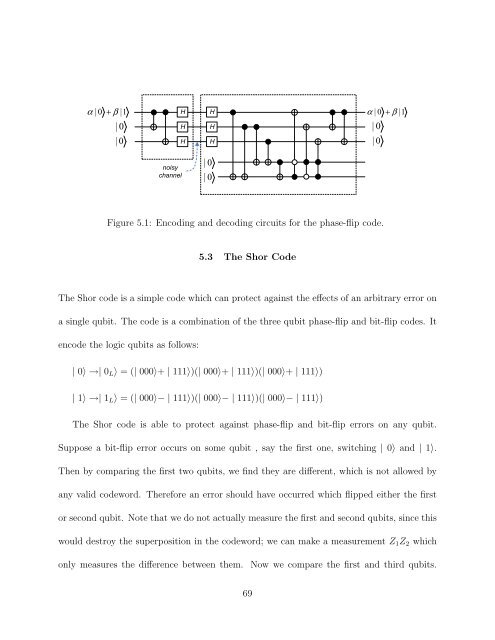t b a b a
t b a b a
t b a b a
You also want an ePaper? Increase the reach of your titles
YUMPU automatically turns print PDFs into web optimized ePapers that Google loves.
α | 0 + β | 1<br />
| 0<br />
| 0<br />
noisy<br />
channel<br />
H H<br />
H H<br />
H H<br />
| 0<br />
| 0<br />
Figure 5.1: Encoding and decoding circuits for the phase-flip code.<br />
5.3 The Shor Code<br />
α | 0 + β | 1<br />
The Shor code is a simple code which can protect against the effects of an arbitrary error on<br />
a single qubit. The code is a combination of the three qubit phase-flip and bit-flip codes. It<br />
encode the logic qubits as follows:<br />
| 0〉 →| 0L〉 = (| 000〉+ | 111〉)(| 000〉+ | 111〉)(| 000〉+ | 111〉)<br />
| 1〉 →| 1L〉 = (| 000〉− | 111〉)(| 000〉− | 111〉)(| 000〉− | 111〉)<br />
The Shor code is able to protect against phase-flip and bit-flip errors on any qubit.<br />
Suppose a bit-flip error occurs on some qubit , say the first one, switching | 0〉 and | 1〉.<br />
Then by comparing the first two qubits, we find they are different, which is not allowed by<br />
any valid codeword. Therefore an error should have occurred which flipped either the first<br />
or second qubit. Note that we do not actually measure the first and second qubits, since this<br />
would destroy the superposition in the codeword; we can make a measurement Z1Z2 which<br />
only measures the difference between them. Now we compare the first and third qubits.<br />
69<br />
| 0<br />
| 0

















